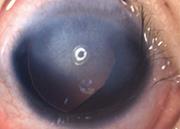Autosomal recessive transmission. It belongs to a group of eye anomalies that results from a disorder of the embryonic development of the eye. They are grouped under the term of dysgenesies of the anterior segment, and concern the cornea, iris, iridocorneal angle and lens. These are the Peters, Axenfeld and Rieger syndromes and the posterior embryotoxon. Mutations of the PAX6 (11p13), FOXC1, PITX2 and CYP1B1 genes have been described in Peters syndrome.
The PAX6, FOXC1 and PITX2 genes are homeobox genes involved in the development of the anterior segment of the eye, while the CYP1B gene codes for a cytochrome intervening in the metabolism of one of the molecules involved in the development of the cornea.
Peters congenital glaucoma is due to an anomaly of the embryologic development during the migration of the mesencephalic neural crests at the end of the third week of intrauterine life. This anomaly causes glaucoma by trabeculodysgenesis. The involvement is often bilateral. There is a lack of development of the membrane of Descemet as well as the endothelium at the center of the cornea leading to a turbidity of the central cornea with iridocorneal synechiae (from the flange of the iris up to the central opacity). The anterior chamber is narrow and even sometimes adherent to the lens. A cataract can be associated. The same neural crest cells are also responsible for the formation of the forebrain, pituitary gland, cartilages, bones of the upper part of the face and dental papillae. This explains the possible association of ocular and dental anomalies, endocrine disorders and facial dysmorphism. Hypospadias can also be present.

Different subtypes have been described:
- Peters type I syndrome: incomplete separation of the cornea and the iris
- Peters type II: more severe, incomplete separation of the cornea and the lens; with keratolenticular adhesions
- Peters-plus syndrome (see this term) associates eye, ear and heart abnormalities, dwarfism, cleft palate and mental retardation
- Krause-Kivlin syndrome combining Peters syndrome and short stature.
With regard to the eye, there is a white corneal opacity, either isolated or associated with iridocorneal synechiae, cataracts or cornea-lens adherence.
The treatment of the glaucoma and cataract, if present, must be completed with a transfixing keratoplasty because of the corneal involvement. A corneal transplantation is often performed durant the first months of life to preserve the child's vision.
Anesthetic implications:
preoperative echocardiography, visual impairement, glaucoma
References :
- Alonso V, Sanchez-Abuin A, Velasco JJ, Marungan de Miguelsanz JM.
Pelvic congestion syndrome secondary to a circumaortic left renal vein.
J Pediatr 2020 ; 220 : 261-2
Updated: June 2020